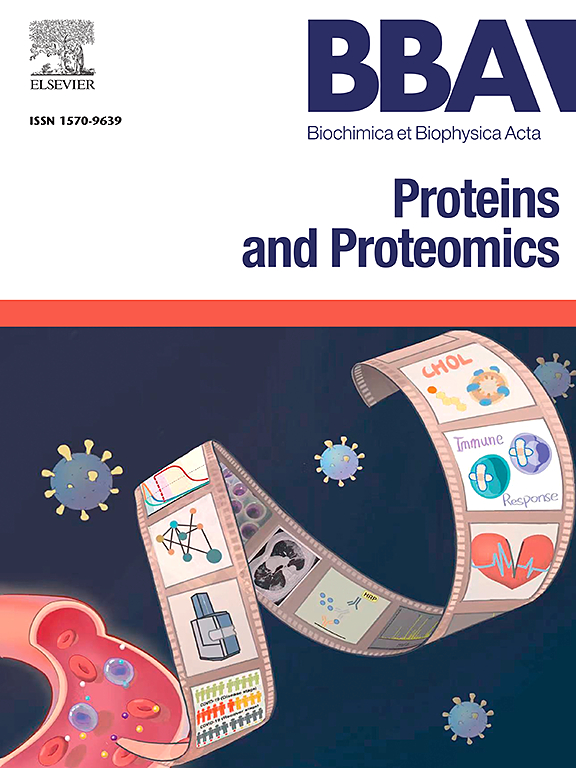绿茶多酚EGCG对不同多元醇渗透产物中α-突触核蛋白终末期淀粉样蛋白多态性的影响存在差异。
IF 2.3
4区 生物学
Q3 BIOCHEMISTRY & MOLECULAR BIOLOGY
Biochimica et biophysica acta. Proteins and proteomics
Pub Date : 2025-04-04
DOI:10.1016/j.bbapap.2025.141073
引用次数: 0
摘要
突触核蛋白病是一组以神经系统中的α-突触核蛋白淀粉样聚集体为特征的异质性疾病。不同的突触核蛋白病临床亚型由结构不同的α-突触核蛋白淀粉样多态性编码,这些多态性被称为 "品系"。多形性之间的潜在结构差异可能会阻碍针对突触核蛋白病的药物设计。EGCG等多酚类化合物有望抑制和重塑α-突触核蛋白淀粉样蛋白聚集体,但它们对不同多态性的影响尚未得到充分研究。细胞环境是造成淀粉样蛋白景观异质性的一个因素。在这里,我们利用不同的多元醇渗透剂(其理化性质各不相同)对α-突触核蛋白的聚集进行微调,从而生成了α-突触核蛋白的多种多态性。这些渗透剂既是球状蛋白质的稳定剂,也是内在无序蛋白质的构象调节剂。缓冲对照组的α-突触核蛋白聚集体分散均匀,而多元醇诱导的聚集体溶液则含有共存的多晶型的异质混合物,这一点可通过原子力显微镜和电子显微镜测量得到证明。多元醇诱导的聚集溶液由富含纤维和非纤维交叉β的物种组成。利用各种光谱工具,我们观察到了渗透剂诱导的多态聚集体结构的差异。我们将这些聚集体与 EGCG 一起培养,观察到 EGCG 对多形态聚集体的不同作用,在这些聚集体中,经过 EGCG 处理的聚集体要么解体,要么结构发生变化。与之前的报道相反,所有经 EGCG 处理的多聚物都富含 β 片层,且具有播种能力。我们的发现有助于评估多酚类化合物对编码不同蛋白病变体的不同聚合菌株的功效。在我们的研究中,富含β片的物种的形成也促使我们对EGCG对不同类别淀粉样蛋白的作用模式进行更严格的审查。本文章由计算机程序翻译,如有差异,请以英文原文为准。

Green tea polyphenol EGCG acts differentially on end-stage amyloid polymorphs of α-synuclein formed in different polyol osmolytes
Synucleinopathies are heterogenous group of disorders characterized by α-synuclein amyloid aggregates in the nervous system. Different synucleinopathy clinical subtypes are encoded by structurally diverse α-synuclein amyloid polymorphs referred to as ‘strains’. The underlying structural differences between polymorphs can potentially hamper the drug design against synucleinopathies. Polyphenolic compounds like EGCG have shown promise in inhibiting and remodeling of α-synuclein amyloid aggregates, but their effects on different polymorphs are not well-studied. The cellular environment is one factor contributing to the heterogeneity in the amyloid landscape. Herein, we generated diverse polymorphs of α-synuclein by fine-tuning its aggregation using different polyol osmolytes, varying in their physicochemical properties. These osmolytes act as globular protein stabilizers and conformational modulators of intrinsically disordered proteins. While the buffer control α-synuclein aggregates were evenly dispersed, the polyol-induced aggregate solutions contained a heterogeneous mixture of co-existing polymorphs, as evidenced by AFM and TEM measurements. The polyol-induced aggregated solutions consisted of a mixture of both fibrillar and nonfibrillar cross-β-rich species. Using various spectroscopic tools, we observed differences in the structures of osmolyte-induced polymorphic aggregates. We incubated these aggregates with EGCG and observed its disparate action over polymorphs wherein the treated species were either disintegrated or structurally altered. Contrary to previous reports, all EGCG-treated polymorphs were β-sheet-rich and seeding-competent. Our findings are relevant in assessing the efficacy of polyphenolic compounds on diverse aggregate strains encoding different proteinopathy variants. The formation of β-sheet-rich species in our study also engenders a more critical examination of EGCG's mode of action on diverse classes of amyloids.
求助全文
通过发布文献求助,成功后即可免费获取论文全文。
去求助
来源期刊
CiteScore
8.00
自引率
0.00%
发文量
55
审稿时长
33 days
期刊介绍:
BBA Proteins and Proteomics covers protein structure conformation and dynamics; protein folding; protein-ligand interactions; enzyme mechanisms, models and kinetics; protein physical properties and spectroscopy; and proteomics and bioinformatics analyses of protein structure, protein function, or protein regulation.

 求助内容:
求助内容: 应助结果提醒方式:
应助结果提醒方式:


